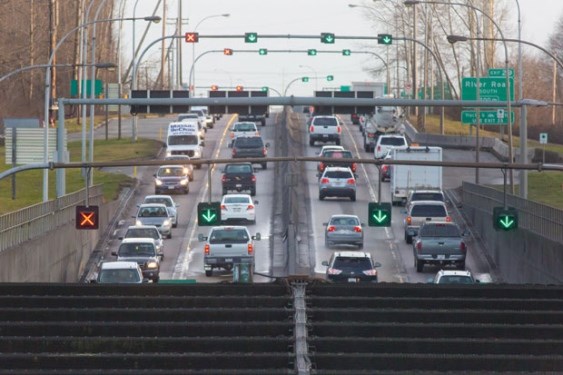While the B.C. government was willing to hold a referendum last May to hike the PST by 0.5 per cent to raise roughly $3 billion for the first 10 years of the transit plan outlined by the region’s mayors, there’s no referendum for the $3.5 billion George Massey Tunnel Replacement Project.
Here we are spending almost the exact same amount the PST increase would have raised, except we aren’t getting a referendum, nor will municipal governments have much in the way of input.
The bridge is far from efficient spending. It isn’t even a transit priority. Here’s what the Mayors’ Transportation and Transit Plan would get us for the same amount: Double the peak capacity of the Expo Line, which sees 200,000 riders a day; increase the frequency of the Canada Line; create 2,700 km of bikeways; maintain major road networks and reduce congestion by 20 per cent along most major roads.
Compared to the George Massey Tunnel, which sees 80,000 vehicles a day and a peak of 8,000 vehicles per hour, the best choice is clearly the Mayors’ Transportation and Transit Plan. One of the greater ironies is from the December 2015 George Massey Tunnel fact sheet, which stated that the bridge would meet modern seismic standards.
“Building a tunnel to the same required standards is a much more costly, complex and environmentally invasive process, involving river-bottom dredging and bringing in layers of sand, gravel and loose stone to reinforce the earth onshore and in the Fraser River below the water.”
It’s ironic because meeting modern seismic standards is far from their priority for a lot of our public infrastructure.
It’s strange and greatly insulting that the B.C. government is forcing hospitals, schools and other important public institutes to beg for money or scrape together whatever they can by any means possible to meet modern seismic standards, while, at the same time, they’re prioritizing a “costly, complex and environmentally invasive process” to achieve seismic standards for a bridge?
A financially prudent idea would be to spend the $2.2 billion requested by Metro Vancouver school districts to upgrade 128 schools at risk for major seismic instability.
It’s quite ironic that the Minister of Transportation, Todd Stone, said that the project is being driven from a place of safety. The choice to prioritize spending to make the bridge seismically sound and safe while these schools packed with tens of thousands of students are at serious risk raises a lot of questions.
Moreover, the $3.5 billion is being spent on a project that is far from transparent. It lacks the input that the Mayor’s Transportation and Transit Plan had.
The most phenomenal and mind-boggling part is that we’re spending our money to replace an already existing tunnel while leaving our transit insufficiently funded and our public institutions cash-strapped.
Freedom of information requests from Coun. Harold Steves about the pros and cons of upgrading the tunnel instead of replacing it, have resulted in no records being located. How is that possible?
How can you make a $3.5 billion decision with no record?
Our population is going to double, but our road size cannot double with it.
It’s time we make a decision regarding what we want to invest in. My answer is clearly public transit.
As an 18-year-old, Vincent Chiu ran in the Richmond Centre riding for the Green Party in the federal election last fall. He was one of the youngest candidates in the country.



